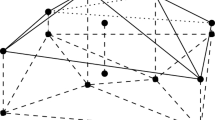Abstract
Estimation of economic relationships often requires imposition of constraints such as positivity or monotonicity on each observation. Methods to impose such constraints, however, vary depending upon the estimation technique employed. We describe a general methodology to impose (observation-specific) constraints for the class of linear regression estimators using a method known as constraint weighted bootstrapping. While this method has received attention in the nonparametric regression literature, we show how it can be applied for both parametric and nonparametric estimators. A benefit of this method is that imposing numerous constraints simultaneously can be performed seamlessly. We apply this method to Norwegian dairy farm data to estimate both unconstrained and constrained parametric and nonparametric models.




Similar content being viewed by others
Notes
See Ajgaonkar (1965) for a formal definition of linear estimators.
See Henderson and Parmeter (2009) for a survey of various methods (including this one) to impose constraints on nonparametrically estimated regression surfaces.
The recent work of Sauer (2006) also advocated for checking and testing for theoretical consistency, albeit in a different setting.
This is not always a bad strategy as Ryan and Wales (2000) have shown that imposing a constraint at a single point may result in that constraint being satisfied at many points.
To appreciate why it may prove necessary to allow for negative weighting, suppose we simply wished to constrain a surface that has both positive and negative regions to be uniformly positive. This could be accomplished by allowing some of the weights to be negative. However, probability weights would fail to produce a feasible solution as they are all non-negative.
A referee has correctly noted the tight link between CWB and empirical likelihood. However, in that setup one minimizes \(\sum\nolimits^n_{i=1}\log\left(p_i/p_u\right)\) subject to a set of moment conditions. CWB as proposed here with a quadratic norm makes solving the constrained problem easier to implement and offers (potentially) extra flexibility to satisfy the constraints by allowing p i < 0.
Other useful economic constraints that satisfy (in)equalities that are linear in p include additive separability, homogeneity, diminishing marginal returns/products, and bounding of derivatives of any order.
Code in the R language is available from the authors upon request.
This methodology also works well with the general order local polynomial estimator as well as with spline regression. We leave a full treatment of this for future research.
Note that X and Y here does not denote regressor and regressand, respectively.
Nomenclature of Territorial Units for Statistics (NUTS) is a geocode standard, developed and regulated by the European Union, for referencing the subdivisions of countries for statistical purposes.
See “Appendix” for the estimates of the 65 parameters from our translog model.
Our unbalanced panel includes n ≡ ∑ N i=1 T i = 4,333 total observations and we want to impose nine inequality constraints. In cases such as this, a relatively powerful computer in terms of speed and memory space is needed. For example, with a single constraint, the linear regression estimator is expressed as a n × n dimensional matrix. Our problem required three gigabytes of memory for the parametric model and four gigabytes for the nonparametric model.
We use the Silverman reflection method to construct the densities for the constrained gradients.
We will consider more formal comparisons in Sect. 5.3.
We are also interested in testing the null that the constrained translog model is correctly specified. Unfortunately, it is unclear how to perform the HLR test in this scenario. We expect that this model will also be rejected, as the deviations from the unconstrained model are minimal, but we do not make a formal claim at this time.
References
Abrevaya J, Jiang W (2005) A nonparametric approach to measuring and testing curvature. J Bus Econ Stat 23:1–19
Ajgaonkar SGP (1965) On a class of linear estimators in sampling with varying probabilities without replacement. J Am Stat Assoc 60(310):637–642
Cressie NAC, Read TRC (1984) Multinomial goodness-of-fit tests. J R Stat Soc Ser B 46:440–464
Diewert W (1992) Fisher ideal output, input, and productivity indexes revisited. J Prod Anal 3:211–248
Diewert WE, Wales TJ (1987) Flexible functional forms and global curvature conditions. Econometrica 55(1):43–68
Du P, Parmeter CF, Racine JS (2012) Nonparametric kernel regression with multiple predictors and multiple shape constraints. Stat Sin (forthcoming)
Epstein LG, Yatchew AJ (1985) Nonparametric hypothesis testing procedures and applications to demand analysis. J Econom 30:149–169
Fan Y, Li Q (1996) Consistent model specification tests: omitted variables and semiparametric functional forms. Econometrica 64:865–890
Färe R, Primont D (1995) Multi-output production and duality: theory and applications. Kluwer, Dordrecht
Hall P, Huang H (2001) Nonparametric kernel regression subject to monotonicity constraints. Ann Stat 29(3):624–647
Hall P, Huang H, Gifford J, Gijbels I (2001) Nonparametric estimation of hazard rate under the constraint of monotonicity. J Comput Graph Stat 10(3):592–614
Härdle W, Mammen E (1993) Comparing nonparametric versus parametric regression fits. Ann Stat 21(4):1926–1947
Henderson DJ, Kumbhakar SC (2006) Public and private capital productivity puzzle: a nonparametric approach. South Econ J 73(2):219–232
Henderson DJ, Millimet DL (2008) Is gravity linear? J Appl Econom 23(1):137–172
Henderson DJ, Parmeter CF (2009) Imposing economic constraints in nonparametric regression: survey, implementation and extension. In: Li Q, Racine JS (eds) Advances in econometrics: nonparametric econometric methods, vol 25. Emerald Group Publishing, Bingley, pp 479–508
Hsiao C, Li Q, Racine JS (2007) A consistent model specification test with mixed categorical and continuous data. J Econom 140:802–826
Hurvich CM, Simonoff JS, Tsai CL (1998) Smoothing parameter selection in nonparametric regression using an improved Akaike information criterion. J R Stat Soc Ser B 60:271–293
Kumbhakar SC (2012) Estimation of production technology using primal approaches. Eur J Oper Res 217(3):509–518
Kumbhakar SC, Lovell CAK (2000) Stochastic frontier analysis. Cambridge University Press, New York
Li Q, Racine J (2007) Nonparametric econometrics: theory and practice. Princeton University Press, Princeton
Matzkin RL (1994) Restrictions of economic theory in nonparametric methods. In: McFadden DL, Engle RF (eds) Handbook of econometrics, vol 4. North-Holland, Amsterdam
McFadden DL (1978) Cost, revenue and profit functions. In: Fuss M, McFadden DL (eds) Production economics: a dual approach to theory and applications, vol 1: the theory of production, pp 2–109
O’Donnell CJ, Coelli TJ (2005) A Bayesian approach to imposing curvature on distance functions. J Econom 126(2):493–523
O’Donnell CJ, Rambaldi AN, Doran HE (2001) Estimating economic relationships subject to firm- and time-varying equality and inequality constraints. J Appl Econom 16(4):709–726
Parmeter CF, Racine JS (2012) Smooth constrained frontier analysis. In: Chen X, Swanson NE (eds) A Festschrift in honour of Halbert L. White Jr. Springer, Berlin
R Development Core Team (2008) R: a language and environment for statistical computing. R Foundation for Statistical Computing, Vienna, Austria. ISBN: 3-900051-07-0
Racine JS, Li Q (2004) Nonparametric estimation of regression functions with both categorical and continuous data. J Econom 119(1):99–130
Rambaldi AN, Doran HE (1997) Applying linear time-varying constraints to econometric models: with an application to demand systems. J Econom 79(1):83–95
Ryan DL, Wales TJ (2000) Imposing local concavity in the translog and generalized Leontief cost functions. Econ Lett 67:253–260
Sauer J (2006) Economic theory and econometric practice: parametric efficiency analysis. Empir Econ 31:1061–1087
Shephard RW (1953) Cost and production functions. Princeton University Press, Princeton
Shephard RW (1970) The theory of cost and production functions. Princeton University Press, Princeton
Terrell D (1996) Incorporating monotonicity and concavity conditions in flexible functional forms. J Appl Econom 11(2):179–194
Yatchew A, Bos L (1997) Nonparametric regression and testing in economic models. J Quant Econ 13:81–131
Zheng J (1996) A consistent test of functional form via nonparametric estimation technique. J Econom 75:263–289
Acknowledgments
The idea of using constraint weighted bootstrapping for parametric models came directly from Jeffrey S. Racine and we acknowledge his insights here.
Author information
Authors and Affiliations
Corresponding author
Appendix: Translog parameter estimates
Appendix: Translog parameter estimates
The parameter estimates for the unconstrained translog model with fixed effects are given in Table 5. Excluding the farm effects, we first note that 33 out of the possible 65 parameter estimates (excluding intercepts) are significant at the 10 % level. We also note that the fit of the model is very high with a squared correlation coefficient between the actual and fitted values equal to 0.9845.
Rights and permissions
About this article
Cite this article
Parmeter, C.F., Sun, K., Henderson, D.J. et al. Estimation and inference under economic restrictions. J Prod Anal 41, 111–129 (2014). https://doi.org/10.1007/s11123-013-0339-x
Published:
Issue Date:
DOI: https://doi.org/10.1007/s11123-013-0339-x




